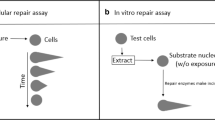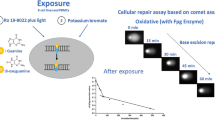Abstract
DNA repair pathways provide a critically important cellular defence system, effectively protecting us from mutations and cancer. Distinct pathways deal with various classes of damage: single- and double-strand breaks, oxidized and alkylated bases, bulky adducts, intra- and inter-strand cross-links. A simple approach to measuring the DNA repair capacity of cell lines, or samples of blood cells, for instance, is the cellular repair assay, or challenge assay, in which cells are treated with a specific DNA-damaging agent, and incubated; at intervals, samples are taken and the residual damage is measured. The comet assay is well suited for measuring strand break rejoining, excision repair of oxidized or alkylated bases (with a lesion-specific endonuclease to convert the altered bases into breaks), and nucleotide excision repair of UV-induced lesions (again, using an appropriate enzyme to detect the damage). An alternative way to assess nucleotide excision repair capability is the incision assay: after UV irradiation, cells are incubated with inhibitors of repair DNA synthesis, so that incomplete repair sites accumulate as DNA breaks.
We provide protocols for these DNA repair assays, and discuss their applications—and their limitations. We also raise some important, so far unanswered questions concerning the regulation of repair, and the factors that might account for the wide variations seen in individual repair capacities.
Access this chapter
Tax calculation will be finalised at checkout
Purchases are for personal use only
Similar content being viewed by others
References
Brand MD, Affourtit C, Esteves TC et al (2004) Mitochondrial superoxide: production, biological effects, and activation of uncoupling proteins. Free Radic Biol Med 37:755–767
Friedberg EC, Walker GC, Siede W et al (2006) DNA repair and mutagenesis. ASM Press, Washington, DC
Iyanagi T (2007) Molecular mechanism of phase I and phase II drug-metabolizing enzymes: implications for detoxification. In: Kwang WJ (ed) International review of cytology, vol 260. Academic, Waltham, pp 35–112
Grollman AP, Moriya M (1993) Mutagenesis by 8-oxoguanine: an enemy within. Trends Genet 9:246–249
Collins AR, Horvathova E (2001) Oxidative DNA damage, antioxidants and DNA repair; applications of the comet assay. Biochem Soc Trans 29:337–341
Goodarzi AA, Jeggo PA (2013) The repair and signaling responses to DNA double-strand breaks. In: Theodore Friedmann JCD (ed) Advances in genetics, vol 82. Academic, New York, pp 1–45
Fortini P, Dogliotti E (2007) Base damage and single-strand break repair: mechanisms and functional significance of short- and long-patch repair subpathways. DNA Repair 6:398–409
Muniandy R, Liu J, Majumdar A et al (2010) DNA interstrand crosslink repair in mammalian cells: step by step. Crit Rev Biochem Mol Biol 45:23–49
Reardon JT, Cheng Y, Sancar A (2006) Repair of DNA–protein cross-links in mammalian cells. Cell Cycle 5:1366–1370
Pegg AE (2000) Repair of O6-alkylguanine by alkyltransferases. Mutat Res 462:83–100
Ford JM (2005) Regulation of DNA damage recognition and nucleotide excision repair: another role for p53. Mutat Res 577:195–202
Collins AR, Ma A, Duthie SJ (1995) The kinetics of repair of oxidative DNA damage (strand breaks and oxidised pyrimidines) in human cells. Mutat Res 336:69–77
Collins AR (2014) Measuring oxidative damage to DNA and its repair with the comet assay. Biochim Biophys Acta. 1840(2):794–800. http://dx.doi.org/10.1016/j.bbagen.2013.04.022
ESCODD, Gedik CM, Collins A (2005) Establishing the background level of base oxidation in human lymphocyte DNA: results of an interlaboratory validation study. FASEB J 19:82–84
Collins AR, Dusinska M, Horska A (2001) Detection of alkylation damage in human lymphocyte DNA with the comet assay. Acta Biochim Pol 48:611–614
Collins AR, Mitchell DL, Zunino A et al (1997) UV-sensitive rodent mutant cell lines of complementation groups 6 and 8 differ phenotypically from their human counterparts. Environ Mol Mutagen 29:152–160
Collins AR, Azqueta A (2012) Single-cell gel electrophoresis combined with lesion-specific enzymes to measure oxidative damage to DNA. Methods Cell Biol 112:69–92
Collins AR (1977) DNA damage in ultraviolet-irradiated HeLa and CHO-K1 cells examined by alkaline lysis and hydroxyapatite chromatography. Biochim Biophys Acta 478:461–473
Hiss ES, Preston RJ (1997) The effect of cytosine arabinoside on the frequency of single-strand breaks in DNA of mammalian cells following irradiation or chemical treatment. Biochim Biophys Acta 478:1–8
Busch DB, Zdzienicka MZ, Natarajan AT et al (1996) A CHO mutant, UV40, that is sensitive to diverse mutagens and represents a new complementation group of mitomycin C sensitivity. Mutat Res 363:209–221
Squires S, Johnson RT, Collins AR (1982) Initial rates of DNA incision in UV-irradiated human cells; differences between normal, xeroderma pigmentosum and tumour cells. Mutat Res 95:389–404
Klaude M, Gedik CM, Collins AR (1995) DNA damage and repair after low doses of UV-C radiation; comparable rates of repair in rodent and human cells. Int J Radiat Biol 67:501–508
Collins AR, Azqueta A, Langie SAS (2012) Effects of micronutrients on DNA repair. Eur J Nutr 51:261–279
Duthie SJ, Pirie L, Jenkinson AM et al (2002) Cryopreserved versus freshly isolated lymphocytes in human biomonitoring: endogenous and induced DNA damage, antioxidant status and repair capability. Mutagenesis 17:211–214
DiGiovanna JJ, Kraemer KH (2012) Shining a light on xeroderma pigmentosum. J Invest Dermatol 132:785–796
Tudek B, Speina E (2012) Oxidatively damaged DNA and its repair in colon carcinogenesis. Mutat Res 736:82–92
Collins AR, Azqueta A (2012) DNA repair as a biomarker in human biomonitoring studies; further applications of the comet assay. Mutat Res 736:122–129
Author information
Authors and Affiliations
Corresponding author
Editor information
Editors and Affiliations
Rights and permissions
Copyright information
© 2014 Springer Science+Business Media New York
About this protocol
Cite this protocol
Collins, A.R., Azqueta, A. (2014). Methods for Measuring DNA Repair: Introduction and Cellular Repair. In: Sierra, L., Gaivão, I. (eds) Genotoxicity and DNA Repair. Methods in Pharmacology and Toxicology. Humana Press, New York, NY. https://doi.org/10.1007/978-1-4939-1068-7_21
Download citation
DOI: https://doi.org/10.1007/978-1-4939-1068-7_21
Published:
Publisher Name: Humana Press, New York, NY
Print ISBN: 978-1-4939-1067-0
Online ISBN: 978-1-4939-1068-7
eBook Packages: Springer Protocols




